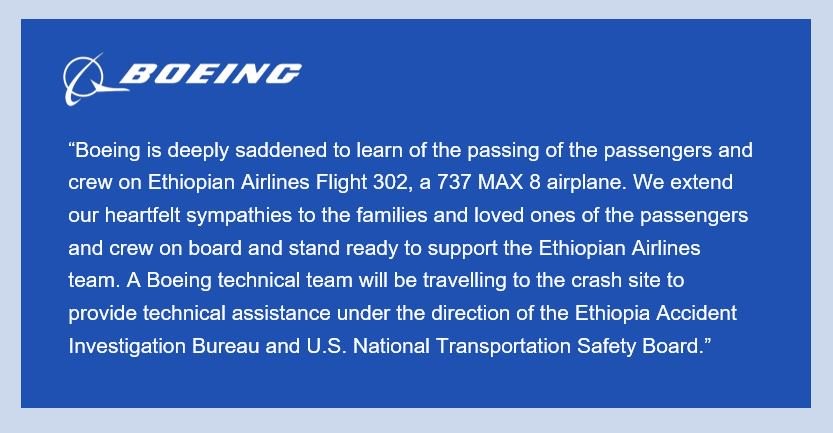The tragic crash of Ethiopian Airlines Flight 302 has catapulted Boeing into a fast-moving media frenzy that illustrates many of the classic characteristics of a corporate crisis. The company’s response – now and in the days ahead – will play a critical role in determining how significantly this moment undermines Boeing’s reputation as a trusted manufacturer.
This crisis puts Boeing at risk of losing the confidence of customers, regulators, shareholders and the general public. Indeed, Boeing’s stock dropped 10% from $422 per share the Friday before the crash to $377 per share two days after the crash as 18 countries and airlines carriers around the world grounded the 737 Max 8.
The crash – coming less than five months after a similar crash of a Boeing 737 MAX 8 in Indonesia – has already had significant operational and reputational impacts. While every situation is different, companies in situations like these need to be prepared to respond immediately – even when they don’t have all the answers. Boeing has made many of the right moves by issuing statements on Twitter and through the media that have emphasized the company’s commitment to safety and its condolences to the 157 passengers who died.
But the true test of their response will be what happens next.

The Lambert crisis team has been monitoring the news this week as new information and revelations continue to shape and shift the narrative. It is clear to us that Boeing will need to continue to respond in real-time to this fast-moving story while also creating a long-term media strategy that will play out in the coming weeks, months and perhaps even longer.
We will certainly learn more in the days, weeks and months to head – but in this initial stage, here are five crisis PR takeaways:
1. Remember the victims. In complex, rapidly evolving, and emotionally charged cases like this one, it is sometimes too easy to lose sight of the real human toll of the crisis. Already in this case, we are hearing more about airplane mechanics and regulatory oversight than we are about those who lost their lives. As a company, whether it’s day 1 or day 10, it’s important that care and concern for those involved remains front of mind in any communication response. That’s a lesson that Boeing got right in the first hours after the crash, and one they should continue to consider as the situation develops.
2. A crisis doesn’t have to happen to you for you to be pulled into the news cycle. The Ethiopian Airlines crash occurred nearly five months after the crash of another Boeing 737 MAX 8 in Indonesia on a flight operated by Lion Air. Even though Lion Air hasn’t had another incident, it’s back in the news because of a similar crash halfway around the world. In fact, even though Ethiopian Airlines was the only company involved at the time of the crash, the crisis has now also enveloped Boeing and the Federal Aviation Administration.
3. In a crisis, the question of who’s at fault (or who’s perceived to be at fault) will drive media coverage. We often refer to this concept as crisis or issue ownership. Many factors can determine ownership. For instance, if something happens to your company (fire, cyberattack, act of God) you may have very little ownership. In other words, you’re more likely to be the victim in news coverage.
On the other hand, if you failed to take proper precautionary measures, such as a having an emergency response plan or appropriate cybersecurity measures – and that lack of foresight made the situation worse – your ownership increases. When your ownership increases, so does your responsibility to act. In the case of the MAX 8’s, we see a complicated narrative with shifting ownership that continues to play out. Depending on the day, and sometimes the hour, attention has shifted from the airlines, to Boeing, and now, to regulators like the U.S. Federal Aviation Administration who are deciding whether to allow the MAX 8 to continue to fly while investigations are underway.
4. While it should go without saying, crises can have a significant impact on your company’s bottom line. According to reporting in The Washington Post, analysts are saying in a worst-case scenario, Boeing could take a $5.1 billion hit – or about 5 percent of the company’s annual revenue – in two months if planes are grounded and production is delayed. That’s to say nothing of the long-term direct and indirect impacts the crisis could have on the company’s reputation and sales.
5. Be aware of the power of social media in a crisis. We can’t understate the impact social media has had on crisis communications. If you’re facing a crisis, it’s imperative you have (and use) social media monitors to track what people are saying about you online. You can’t – and shouldn’t – try to respond to everything and everyone. In fact, you’ll probably be able to say very little publicly in the first hours, and even days, after an event. But if you’re Boeing, in this case, you should be trying to have your finger on the pulse of stakeholder sentiment as you develop short- and long-term strategies. Social media is likely the fastest way that you’ll find out, for instance, that CNBC is reporting that the flight attendants at one of your major customers are calling for your planes to be grounded.
American Airlines flight attendants call for Boeing 737 MAX-8 to be grounded: “We are calling on our CEO Doug Parker to strongly consider grounding these planes until a thorough investigation can be performed. While we cannot draw premature conclusion.”
— Phil LeBeau (@Lebeaucarnews) March 12, 2019

